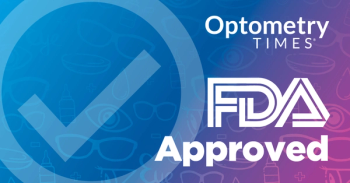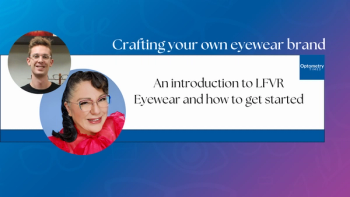
- July/August digital edition 2025
- Volume 17
- Issue 04
Myopia is an escalating global health crisis
Understanding the scale and scope, by the numbers.
Myopia has rapidly become one of the most pressing public health challenges of the 21st century. Once considered a benign refractive error easily corrected with glasses or contact lenses, it is now recognized as a progressive, potentially sight-threatening disease. In developing countries, myopia is a leading cause of preventable blindness.1 Beyond impairing distance vision, myopia significantly increases the risk of severe ocular comorbidities and contributes to a growing global socioeconomic burden. With prevalence rates rising rapidly among children and adolescents, particularly in urbanized and developed regions, projections estimate that by 2050, nearly half of the world’s population will be myopic.2,3
Rising prevalence and future projections
The global prevalence of myopia has surged from 22.9% in 2000 to an estimated 34% in 2020 and is expected to reach 50% by 2050, affecting nearly 5 billion people.2,4 High myopia (≤ −6.00 diopters [D]), which carries a heightened risk of pathological complications, is projected to affect almost 10% of the global population by 2050.5
Recent meta-analyses indicate that among children and adolescents, the prevalence of myopia increased from 24.3% in 1990 to 35.8% in 2023 and is forecasted to exceed 39% by 2050.3 The highest rates of myopia are currently seen in East Asia and urban areas.3
Associated comorbidities and risks
The progression of myopia, particularly to high levels, is associated with irreversible vision-threatening conditions, which include the following:
Myopic maculopathy: This is the leading cause of blindness in individuals with myopia, characterized by progressive retinal atrophy and significant loss in best corrected vision.6-8 Even children are affected; in a study of 274 children and adolescents (ages 7 to 17) with high myopia (≤ –6.00 D), 12.2% developed myopic maculopathy over 4 years.9
Retinal detachment: Myopic eyes are structurally elongated, predisposing them to retinal holes, lattice degeneration, vitreoretinal traction, and detachment.10,11
Glaucoma and early-onset cataracts: Structural changes in highly myopic eyes increase susceptibility to these conditions.12-14 The risk of glaucoma increases by about 20% for every increase of 1 D in myopia, with a disproportionately greater risk observed in individuals with high myopia.15
Recent analyses have shown that there is no safe level of myopia.6 Even low to moderate myopia significantly increases lifetime risk. Each additional diopter of myopia increases the risk of myopic maculopathy by 67%, whereas slowing progression by just 1.00 D could reduce the risk by 40%.6 This relationship holds across all degrees of myopia, emphasizing that even seemingly mild cases carry substantial lifelong risk.
Drivers of the myopia epidemic
Although genetic predisposition plays a significant role in myopia development, particularly among children with at least 1 parent with the condition, the recent, dramatic global surge in prevalence cannot be attributed to genetics alone. The rate of increase is too rapid to be explained by hereditary shifts, implicating environmental factors as the primary drivers of this epidemic. Large-scale studies confirm that while heritability contributes substantially to risk, environmental exposures, such as near work and reduced outdoor time, are critical modulators of myopia onset and progression.16-19
Urbanization has emerged as a major contributor, with children living in urban areas consistently demonstrating higher myopia rates than those residing in rural environments. This disparity is likely due to differences in lifestyle, including less time spent outdoors and greater engagement in near tasks such as reading and screen use.7,20 Reduced time outdoors is a well-established risk factor for myopia progression in children and adolescents.21-24 Exposure to natural light is believed to stimulate retinal dopamine release, a key factor in inhibiting axial elongation, thereby offering a protective effect against myopia.25
Conversely, increased near work and screen time have been associated with higher risks of both myopia onset and progression.7,17,18,26,27 The COVID-19 pandemic exacerbated these environmental risks by shifting children’s activities indoors and dramatically increasing screen-based learning and entertainment. Studies during lockdowns revealed a marked rise in myopia incidence, especially among children aged 6 to 8 years.3,28 One large-scale Chinese study reported a mean myopic shift of up to –0.30 D within just a few months of confinement—an acceleration unprecedented in previous years.28
Early-onset myopia, particularly before the age of 10, is strongly associated with faster rates of progression and a markedly increased lifetime risk of developing high myopia and its associated sight-threatening complications. 29-32 Younger children experience more rapid axial elongation and faster spherical equivalent changes compared with those with later onset, making early identification and timely intervention critical to mitigate future risks. Evidence indicates that children with earlier myopia onset not only have faster annual progression rates—often exceeding −0.75 D per year—but are also more likely to experience sustained, rapid progression over subsequent years if left untreated.29-32
Economic and quality-of-life burden
The global economic burden of myopia is substantial. In 2015, the potential productivity loss from uncorrected myopia was estimated at $244 billion, with an additional $6 billion attributable to myopic macular degeneration.33 Direct costs include refractive correction, clinical management of complications, and surgical interventions. Indirect costs include reduced work productivity, poorer school performance, and diminished quality of life (QOL).
Importantly, individuals with myopia experience significantly lower vision-related QOL compared with emmetropes, even after optical correction. Myopia adversely affects both visual functioning and socioemotional well-being, with even very low degrees of myopia associated with substantial declines in QOL.34 Studies have shown that high myopia impairs QOL to an extent comparable with keratoconus, an ocular condition traditionally associated with significant disability.35 Factors such as dependency on optical correction, limitations in recreational activities, reduced self-esteem, and financial burden related to ongoing care contribute to this diminished QOL.
Conclusion
The rise in myopia is not only a crisis of visual acuity but also a looming epidemic of vision impairment and blindness. It is imperative that clinicians, educators, policymakers, and parents act collaboratively to implement evidence-based strategies to address this growing burden.
Focusing efforts on delaying the onset and slowing the progression of myopia, particularly during childhood, has the potential to significantly reduce future ocular morbidity and socioeconomic costs. Immediate action is essential to protect the visual health and QOL of future generations.
References:
Congdon NG, Friedman DS, Lietman T. Important causes of visual impairment in the world today. JAMA. 2003;290(15):2057-2060. doi:10.1001/jama.290.15.2057
Holden BA, Fricke TR, Wilson DA, et al. Global prevalence of myopia and high myopia and temporal trends from 2000 through 2050. Ophthalmology. 2016;123(5):1036-1042. doi:10.1016/j.ophtha.2016.01.006
Liang J, Pu Y, Chen J, et al. Global prevalence, trend and projection of myopia in children and adolescents from 1990 to 2050: a comprehensive systematic review and meta-analysis. Br J Ophthalmol. 2025;109(3):362-371. doi:10.1136/bjo-2024-325427
Sankaridurg P, Tahhan N, Kandel H, et al. IMI impact of myopia. Invest Ophthalmol Vis Sci. 2021;62(5):2. doi:10.1167/iovs.62.5.2
Fricke TR, Jong M, Naidoo KS, et al. Global prevalence of visual impairment associated with myopic macular degeneration and temporal trends from 2000 through 2050: systematic review, meta-analysis and modelling. Br J Ophthalmol. 2018 ;102(7):855-862. doi:10.1136/bjophthalmol-2017-311266
Bullimore MA, Brennan NA. Myopia control: why each diopter matters. Optom Vis Sci. 2019;96(6):463-465. doi:10.1097/OPX.0000000000001367
Flitcroft DI, Harb EN, Wildsoet CF. The spatial frequency content of urban and indoor environments as a potential risk factor for myopia development. Invest Ophthalmol Vis Sci. 2020;61(11):42. doi:10.1167/iovs.61.11.42
Vongphanit J, Mitchell P, Wang JJ. Prevalence and progression of myopic retinopathy in an older population. Ophthalmology. 2002;109(4):704-711. doi:10.1016/s0161-6420(01)01024-7
Jiang F, Wang D, Xiao O, et al. Four-year progression of myopic maculopathy in children and adolescents with high myopia. JAMA Ophthalmol. 2024;142(3):180-186. doi:10.1001/jamaophthalmol.2023.6319
Haarman AEG, Enthoven CA, Tideman JWL, Tedja MS, Verhoeven VJM, Klaver CCW. The complications of myopia: a review and meta-analysis. Invest Ophthalmol Vis Sci. 2020;61(4):49. doi:10.1167/iovs.61.4.49
van Leeuwen R, Haarman AEG, van de Put MAJ, Klaver CCW, Los LI; Dutch Rhegmatogenous Retinal Detachment Study Group. Association of rhegmatogenous retinal detachment incidence with myopia prevalence in the Netherlands. JAMA Ophthalmol. 2021;139(1):85-92. doi:10.1001/jamaophthalmol.2020.5114
Lim R, Mitchell P, Cumming RG. Refractive associations with cataract: the Blue Mountains Eye Study. Invest Ophthalmol Vis Sci. 1999;40(12):3021-3026.
Mitchell P, Hourihan F, Sandbach J, Wang JJ. The relationship between glaucoma and myopia: the Blue Mountains Eye Study. Ophthalmology. 1999;106(10):2010-2015. doi:10.1016/s0161-6420(99)90416-5
Czudowska MA, Ramdas WD, Wolfs RC, et al. Incidence of glaucomatous visual field loss: a ten-year follow-up from the Rotterdam Study. Ophthalmology. 2010;117(9):1705-1712. doi:10.1016/j.ophtha.2010.01.034
Ha A, Kim CY, Shim SR, Chang IB, Kim YK. Degree of myopia and glaucoma risk: a dose-response meta-analysis. Am J Ophthalmol. 2022;236:107-119. doi:10.1016/j.ajo.2021.10.007
Tedja MS, Haarman AEG, Meester-Smoor MA, et al;
CREAM Consortium . IMI - Myopia Genetics Report. Invest Ophthalmol Vis Sci. 2019;60(3):M89-M105. doi:10.1167/iovs.18-25965Huang HM, Chang DS, Wu PC. The association between near work activities and myopia in children-a systematic review and meta-analysis. PLoS One. 2015;10(10):e0140419. doi:10.1371/journal.pone.0140419
Wen L, Cao Y, Cheng Q, et al. Objectively measured near work, outdoor exposure and myopia in children. Br J Ophthalmol. 2020;104(11):1542-1547. doi:10.1136/bjophthalmol-2019-315258
Mutti DO. Hereditary and environmental contributions to emmetropization and myopia. Optom Vis Sci. 2010;87(4):255-259. doi:10.1097/OPX.0b013e3181c95a24
Grzybowski A, Kanclerz P, Tsubota K, Lanca C, Saw SM. A review on the epidemiology of myopia in school children worldwide. BMC Ophthalmol. 2020;20(1):27. doi:10.1186/s12886-019-1220-0
Jones LA, Sinnott LT, Mutti DO,
Mitchell GL,Moeschberger ML,Zadnik K. Parental history of myopia, sports and outdoor activities, and future myopia. Invest Ophthalmol Vis Sci. 2007;48:(8):3524-3532. doi:10.1167/iovs.06-1118Rose KA, Morgan IG, Ip J, et al. Outdoor activity reduces the prevalence of myopia in children. Ophthalmology. 2008;115(8):1279-1285. doi:10.1016/j.ophtha.2007.12.019
Xiong S, Sankaridurg P, Naduvilath T, et al. Time spent in outdoor activities in relation to myopia prevention and control: a meta-analysis and systematic review. Acta Ophthalmol. 2017;95(6):551-566. doi:10.1111/aos.13403
Cao K, Wan Y, Yusufu M, Wang N. Significance of outdoor time for myopia prevention: a systematic review and meta-analysis based on randomized controlled trials. Ophthalmic Res. 2020;63(2):97-105. doi:10.1159/000501937
Landis EG, Park HN, Chrenek M, et al. Ambient light regulates retinal dopamine signaling and myopia susceptibility. Invest Ophthalmol Vis Sci. 2021;62(1):28. doi:10.1167/iovs.62.1.28
Foreman J, Salim AT, Praveen A, et al. Association between digital smart device use and myopia: a systematic review and meta-analysis. Lancet Digit Health. 2021;3(12):e806-e818. doi:10.1016/S2589-7500(21)00135-7
He AQ, Liu SA, He SY, et al. Investigation of children’s habits of smartphone usage and parental awareness of myopia control in underdeveloped areas of China. Int J Ophthalmol. 2022;15(10):1691-1698. doi:10.18240/ijo.2022.10.19
Wang J, Li Y, Musch DC, et al. Progression of myopia in school-aged children after COVID-19 home confinement. JAMA Ophthalmol. 2021;139(3):293-300. doi:10.1001/jamaophthalmol.2020.6239
Manoharan MK, Thakur S, Dhakal R, et al. Myopia progression risk assessment score (MPRAS): a promising new tool for risk stratification. Sci Rep. 2023;13(1):8858. doi:10.1038/s41598-023-35696-2
Matsumura S, Lanca C, Htoon HM, et al. Annual myopia progression and subsequent 2-year myopia progression in Singaporean children. Transl Vis Sci Technol. 2020;9(13):12. doi:10.1167/tvst.9.13.12
Jones-Jordan LA, Sinnott LT, Chu RH, et al; CLEERE Study Group. Myopia progression as a function of sex, age, and ethnicity. Invest Ophthalmol Vis Sci. 2021;62(10):36. doi:10.1167/iovs.62.10.36
Qin Z, Peng T, Zhang Z, et al. Myopia progression and stabilization in school-aged children with single-vision lenses. Acta Ophthalmol. 2022;100(4):e950-e956. doi:10.1111/aos.15038
Naidoo KS, Fricke TR, Frick KD, et al. Potential lost productivity resulting from the global burden of myopia: systematic review, meta-analysis, and modeling. Ophthalmology. 2019;126(3):338-346. doi:10.1016/j.ophtha.2018.10.029
Rajabpour M, Kangari H, Pesudovs K, et al. Refractive error and vision related quality of life. BMC Ophthalmology. 2024;24(1):83. doi:10.1186/s12886-024-03350-8
Rose K, Harper R, Tromans C, et al. Quality of life in myopia. Br J Ophthalmol. 2000;84(9):1031-1034. doi:10.1136/bjo.84.9.1031
Articles in this issue
3 months ago
Inside genetics and glaucoma4 months ago
Embracing dry eye4 months ago
A case of orthokeratology for high myopiaNewsletter
Want more insights like this? Subscribe to Optometry Times and get clinical pearls and practice tips delivered straight to your inbox.
















































.png)


